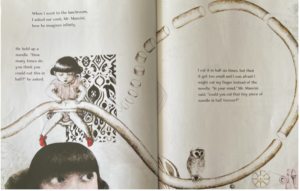Infinity and Me
Junior (Age 9 – 12)
Curriculum Goal
Junior:
- Identify and describe repeating and growing patterns, including patterns found in real-life contexts
- Compare and order integers, decimal numbers, and fractions, separately and in combination, in various contexts
- Represent fractions from halves to tenths using drawings, tools, and standard fractional notation, and explain the meanings of the denominator and the numerator
Context
- Students should understand place value, growing and shrinking patterns, and have experience with fractions and proportional language.
Materials
- Book: “Infinity and Me” by Kate Hosford
- Read Aloud Available – Infinity and Me: Approaching Math through Story
- Scrap Paper
- Pencil
- Markers (one per student)
- Strips of legal paper (one per student)
- Cut paper in half vertically when paper is positioned in a portrait orientation
- Calculators
Lesson
Introduction:
- Introduce the book Infinity and Me to the students: Today we are going to learn about infinity by listening to a story about Uma and how they developed their own understanding of what infinity means. Let’s see how Uma learns about infinity…
- Read or by play the read aloud of Infinity and Me.
- After students listen to the read aloud initiate an open-ended discussion where students offer ideas and examples of infinity.
Lesson:
- Revisit the page from the book below or start playing the read aloud at 3 minutes.

- Guide students to understand that things can become infinitely small as well as infinitely large. Ask students: Is there a limit to how many times you can cut something in half?
- Disperse one strip of precut legal-sized paper and a marker to each student.
- Challenge students to determine how many times they can fold a strip of paper in half. Have students share what they are observing as they make more folds. As students fold, what happens to the number and size of the sections? Could this folding go on forever? Emphasize that there is a difference between what is practically possible (limited) and what is theoretically possible (no limit).
- Tell students that there is a limitation to how many times they can fold their strips of paper but that they are going to soon discover that they can keep cutting something in half forever when they go beyond physically folding strips of paper.
- Project following table and draw a number line spanning from 0 to 1.
Number of Folds | Number of Sections | Fraction | Decimal |
1 | |||
2 | |||
3 | |||
4 |
- Instruct students to hold their strip of paper horizontally or long ways like a ruler. Tell students to fold the strip of paper in half so that the two ends meet.
- Ask students to open their folded strip and to draw a line along the fold with their marker.
- Follow up by asking students:
- How many sections on your strip of paper do you see?
- What fraction of the whole is each section?
- What does this fraction look like as a decimal?
- Have students place on the number line.
- Tell students to refold their strip of paper the same way they did the first time and then tell them to fold it in half again.
- Strips of paper will be smaller but thicker with more folds.
- Have students open the folded paper and trace the lines along the folds.
- Ask students the following:
- How many sections are there now?
- What fraction of the whole is each section?
- What does this fraction look like as a decimal?
- Have students place on the number line.
- Tell students to refold their strip of paper for a third time.
- Have students open the folded paper and draw the lines along the new folds.
- Ask students:
- How many sections are there now?
- What fraction of the whole is each section?
- What does this fraction look like as a decimal?
- Have students place on the number line.
- Tell students to refold their strip of paper making four folds now.
Before students open their strip of paper ask students to use the data in the table to determine how many sections will be present after four folds? Number of sections doubles with each fold.
- Ask students to open the folded paper and draw lines along the new folds.
- Ask students:
- How many sections are there now?
- What fraction of the whole is each section?
- What does this fraction look like as a decimal?
- Have students place on the number line.
- Ask students to share patterns and observations they have identified using data from the table. What do they notice about the denominator of the fraction? Will the decimal number ever reach 0?
- Challenge students to think about if no one shares this fraction. Another way to think about 1/0 is how many times does one go into zero? This answer is undefined.
Conclusion:
- Tell students: If we continued to extend our table by adding more theoretical folds, we would get closer and closer to infinity but would never reach it. When Mr. Mancini asked Uma, “could you cut that tiny piece of noodle in half forever?” we now know that the answer would be yes!
Look Fors
- Do students understand that things can be infinitely small as well as infinitely large?
- Can students translate fractions to decimals to placement on the number line?
- What language is being used when students describe and complete the table?
- How well do students identity patterns within the table?
Created by: Hannah Genich
Share this lesson
Share on facebook
Share on twitter
Share on email
